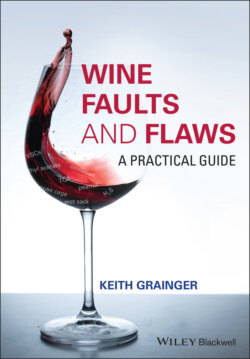Читать книгу Wine Faults and Flaws - Keith Grainger - Страница 17
1.5 Sulfur Dioxide and Other Possible Allergens
ОглавлениеSome individuals are allergic to grapes or alcohol. However, some compounds may be present in wine that may cause allergic reactions. The most important of these is sulfur dioxide (SO2), which is generally added at several stages of the winemaking process for its antimicrobial and antioxidant properties. Even if none is added by the winemaker, most wine contains SO2 as it is naturally formed by yeast during the alcoholic fermentation. Allergic reactions to this compound, which is also used as a preservative in a wide range of foods and drinks, are not uncommon, and individuals with asthma may suffer particularly adverse reactions. Many other people show an intolerance. The total SO2 content of wine is regulated in the European Union (EU) and all major markets and any wine marketed that exceeds this must be considered as both faulty and illegal.
Certain processing aids, particularly fining agents, contain milk or egg products, which are allergens. For wines marketed in the EU, allergen labelling was made compulsory from 25 November 2005 under a European Commission Directive. Initially only the presence of sulfites/sulfur dioxide had to be declared on the label, for concentrations at or exceeding 10 mg/l. This threshold remains applicable. Most wines will contain in excess of this figure even if no SO2 is added during the production process. In 2007 European Directive EC 2007/68 was issued, which provided for the mandatory labelling of further allergens – this directive has since been incorporated into EU Regulation No. 1169/2011 [9]. Due to objections from the wine industry this did not generally come into force until 2012. Insofar as wine is concerned, the only further allergens to be declared on the label are milk or egg products, if the concentration of either exceeds 0.25 mg/l. The current EU wine labelling regulations (EC) No: 2019/33 state the wording and form of allergen labelling information [10]. Wine marketed in the European Union remains exempt from the compulsory ingredients listing that was introduced for food products in 2011: EU Regulation No.: 1169/2011 [9].
